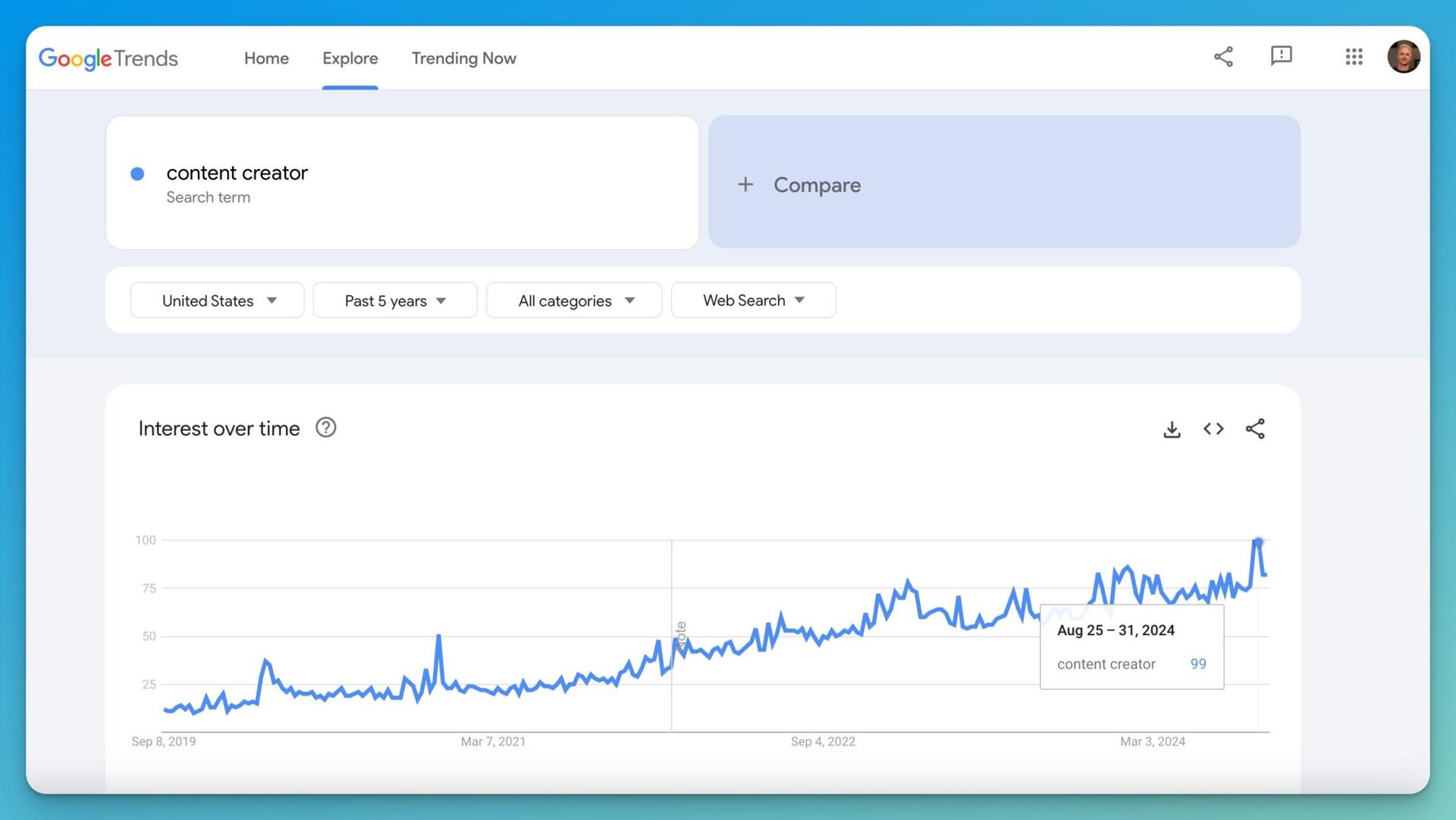Keyword Clustering 101: Beginner’s Guide to Creating SEO Keyword Clusters

You’ve probably heard the term keyword clustering… but maybe you’re not quite sure what it’s all about, or whether it’s worth your time.
🔑 Let me tell you firsthand, as a creator that’s grown my own blog’s traffic to more than 500,000+ monthly readers—I would not have been able to achieve that without investing time into building out my SEO keyword clusters.
In this guide, I’ll be taking you through everything you need to know about keyword clustering in a straightforward, step-by-step process. I recommend you follow along with me as we go, creating your first keyword clusters using our Keyword Cluster Tool (a free RightBlogger account will unlock this tool for you).

Tip: You’ll need to sign up for a free RightBlogger account if you don’t already have one. This gives you access to tons of my most powerful content & SEO tools, and we don’t require a credit card in order to make your free account.
Create Automated SEO Blog Posts in Minutes with RightBlogger

Join 45,417+ bloggers, creators, marketers, writers, & business owners in using RightBlogger’s powerful autoblogging tools. You’ll unlock 80+ blogging, SEO, and marketing AI tools to create content faster & more effectively today. Plus, you’ll access our library of courses, a private community, Tool Studio’s AI lead magnet builder, and more.
Let’s dig into keyword clustering, talk about why it’s important, and see how to approach mapping out your very own keyword clusters for your blog.
If (like me) you’re a visual learner, here’s a great video tutorial on quickly creating keyword clusters using RightBlogger’s Keyword Cluster tool:
If you’re not sure how to organize your keywords for optimal SEO impact, or if you feel your blog isn’t getting the traffic that you want, this guide is for you.
What is Keyword Clustering and Why Does it Matter?
“Keyword clustering” sounds a bit technical, huh? Thankfully, it’s actually pretty simple to wrap your head around. Let’s break down what you need to know, before we dig into how to create keyword clusters.
Understanding the Basics of Keyword Clustering
🔑 Keyword clustering is the practice of grouping together related keywords (common search queries) to streamline your content strategy. By mapping out your approach to content creation using keyword clusters, you’ll identify the most common challenges people face within your industry, and give yourself a foundation to meeting those needs with stellar content.

The keyword clustering process involves identifying a core topic and then creating groups of associated keywords (related categories and themes) around it.
For instance, if your core topic is “digital marketing,” a few of your keyword clusters (related keyword groups) could fall into categories like “SEO”, “content marketing”, and “social media marketing” to name just a few:

This approach helps search engines understand the relevance of your content to a particular topic, making it more likely for your site (and it’s individual content pages) to appear in relevant search results.
The Importance of Keyword Clustering for SEO
Keyword clustering isn’t just a handy organizational tool (though it’s great for mapping out all your major content categories). It’s real value is as a total game-changer for your SEO strategy.
When your content covers everything within a comprehensive cluster of related keywords, you’re essentially telling search engines like Google that you’re super-knowledgeable about that topic. Google loves authoritative content that dives deep into every corner of a niche.

This makes it more likely to rank for multiple (or all) keywords in that cluster—boosting your visibility and driving more traffic to your site.
Keyword clusters are also a great opportunity for internal linking (linking between different pages on your own site). Google can follow these internal links to easily find your different pages, and to figure out—based on the number of links—which pieces of content are most important.
So now you understand the why behind keyword clustering, let’s take a look at how to do this process in a way that generates you real results.
How to Implement Keyword Clustering in Your Blogging Strategy
Here we go, our step-by-step process for creating a keyword cluster.
Step 1. Do Keyword Research
When it comes to keyword clustering, the first step is carrying out thorough keyword research. This involves digging into the common phrases, terms, and challenges people are searching for answers to within your niche.
You can use the RightBlogger’s Keyword Research tool for this.
For instance, if you write about personal finance, a couple of those keywords might be things like “best personal finance books” and “get out of debt”.

Tools like RightBlogger and Google Keyword Planner (plus more pricy tools like SEMRush and Ahrefs) can provide valuable insights into search volume, competition, and related keywords.
🔑 I recommend looking for keywords with low or medium competition and with monthly search volume in the range between 500 to 5,000 monthly searches. Choosing these kinds of topics set you up for quicker wins by going after terms that are easier to rank for, even with a newer website.
Step 2. Group Your Keywords into Clusters
Once you’ve gathered a pool of relevant keywords, the next step is to group them into clusters (categories) based on semantic similarity and user intent. You can export a CSV from the keyword tool and then organize your clusters manually using Google Sheets or Microsoft Excel.
You’ll want to create several different clusters, each with a group of keywords. For instance, if your seed keyword is “hiking gear”, you might have one cluster on “tents” and another cluster on “backpacks”.
Tip: Want to save tons of time here? RightBlogger can come up with keyword clusters for you in just a few clicks. Pick a broad topic or seed keyword (it’s fine if this has a high competition rating) and use that in the Keyword Cluster Tool. You can then check out the search volume and competition of each of the individual keywords in your clusters using the Keyword Research Tool, so you know which ones to prioritize.

Step 3. Create Content Around Your Keyword Clusters
Now that you’ve pinpointed different keywords and have them arranged into specific keyword clusters with all their related terms, it’s time to create your content on those topics.
For every keyword on your list, you’re aiming to create high-quality, comprehensive piece of content. Consider also, which type of content will best meet the need of this particular search term.

With the higher-level keywords (the headings for the clusters), you can create pillar pages—ultimate guide style pieces—that link out to all your other related content pieces, for the individual keywords within that cluster.
This “hub and spoke” model of content is a great approach to building out your SEO approach to encouraging search engines like Google to rank more of your content, higher.

Crafting pillar pages and supporting content within each cluster strengthens the topical authority of your website, boosting your search engine visibility and driving more targeted traffic.
This isn’t about creating a huge quantity of content without a thought for quality. Instead, you’re looking to craft genuinely useful content that fully delivers what readers are looking for when they type their query into Google.
Some RightBlogger tools that can help you here include:
- The Article Writer tool: create full, SEO-optimized first draft articles from your chosen keyword
- The Post Outline tool: generate an outline for your post (you can also create and edit an outline within the Article Writer)
- The Post Introduction tool: craft an engaging introduction to your post
- The Post Conclusion tool: end your post with a strong conclusion and call to action (CTA)
- The FAQs tool: add extra depth and value to your post by answering common questions
Analyzing and Taking Action on Your SEO Keyword Clusters
Alright, so I’m thinking we’ve got you convinced that keyword clustering is a really smart SEO strategy—and we’ve walked step-by-step through how to do it.

Let’s take this guide a step further with some of our best practices for analyzing, interpreting and taking action on this data—to make sure you’re getting the most from your SEO keyword clusters.
Understanding Relevancy and User Intent
When creating your keyword clusters, it’s really important to focus on relevancy and user intent. This means grouping together keywords that are semantically similar and align with the overall theme of your content. This’ll help you prioritize how you approach creating content that meets these keyword opportunities.
🔑 What are real people in your target audience actually searching for and how can you structure your individual content pieces to meet that demand, in exactly the way they’re hoping for in terms of answers, help, or solutions?

“User intent” is just a fancy way of saying “what people are looking for when they search for this keyword.” Are they looking to find a recommendation or even buy something? Or do they just want information?
As you create your keyword clusters, think about how you can bring together keywords with similar user intent. Make sure your clusters are actually relevant to your blog and your existing audience, too.
Monitoring and Updating Your Keyword Clusters
Keyword clustering isn’t a one-time task. You’ll want to keep monitoring your articles and how they’re performing, perhaps with plans to add more content to a particular cluster with a lot of traffic opportunity over the coming months.
This is important for a couple of reasons I’ve seen happen often over the years—sometimes a new keyword will appear on the scene in your niche, or an important term suddenly becomes way more popular.

Free tools like Google Analytics and Google Trends can provide valuable insights into keyword performance and help you make informed decisions about refining & adding to your keyword clusters over time.
Incorporating Long-Tail Keywords
Incorporating long-tail keywords (usually keywords of four or more words) into your keyword clusters can enhance their specificity and capture more targeted traffic.
For instance, instead of using a broad term like “digital marketing,” you could include long-tail keywords such as “best digital marketing strategies for startups” or “digital marketing tools for small businesses.” By integrating long-tail keywords strategically, you can address niche topics and bring your ideal customers to your site.
Tip: The RightBlogger Keyword Cluster tool automatically does this for you, giving you multiple long-tail keywords for each of your clusters.
4 Best Tools for Effective SEO Keyword Clustering
These tools will all help make your keyword clustering and research process go much more smoothly.
1. RightBlogger’s Keyword Cluster Tool

RightBlogger’s built-in Keyword Cluster tool is, as you might imagine, our vision for the perfect SEO keyword clustering tool. It’s everything we want to see in a tool like this—and none of the extra complexity that can so easily overwhelm and confuse most content creators.
We’ve also got a comprehensive Keyword Research tool to help you find more keyword opportunities to create content about. You can check search volumes and see the competition level, along with tools like Smart Suggest, to find winning potential topics for your blog.
You can even use the Backlink Checker for keyword research: check out what content your competitors are getting lots of backlinks to… as that content is likely based around a great keyword phrase.
2. Google Keyword Planner

Google Keyword Planner is free and a pretty solid basic keyword research tool (you will need to sign up for a Google Ads account to use it, but you don’t need to actually pay to run any ads).
It’s ideal for understanding search volumes, competition, and discovering new keyword ideas. If you’re not using the RightBlogger Keyword Research Tool, Google Keyword Planner is a good alternative.
3. SEMRush

SEMRush is like a Swiss Army knife for SEO tools. It not only helps with keyword clustering but also provides insights into competitors’ strategies, backlink analysis, and more. The biggest downsides are complexity and a high price tag.
With SEMRush, you can go pretty deep into keyword clustering, by understanding the competitive landscape and finding new keyword opportunities. However, it’s not a cheap tool, so it’s not a great option for bloggers or businesses on a budget for these kinds of tools.
4. Ahrefs

Ahrefs is a powerhouse when it comes to advanced keyword research and clustering. Its super robust features let you explore keywords, analyze backlinks, and understand content gaps. You can use it to identify hidden opportunities and come up with a comprehensive SEO strategy.
Like Semrush, Ahrefs is for advanced SEOs and content creators, and comes at a very premium price point. It’s best used once you’re already making a steady income from your blog or online business and you’re ready to scale big time.
Keyword Clustering (Faster) Using RightBlogger
Keyword clustering is one of my favorite, most powerful SEO strategies that can massively boost your website’s visibility and organic search engine traffic.
By organizing related keywords into groups and creating targeted content around them, you’ll signal to Google that your site is a great resource for a particular topic.
We designed the Keyword Cluster tool to make keyword clustering as quick and easy as possible for you. Give it a try today with a totally free RightBlogger account. It’s your first step to building lots of great content to bring search traffic to your site.
Create Automated SEO Blog Posts in Minutes with RightBlogger

Join 45,417+ bloggers, creators, marketers, writers, & business owners in using RightBlogger’s powerful autoblogging tools. You’ll unlock 80+ blogging, SEO, and marketing AI tools to create content faster & more effectively today. Plus, you’ll access our library of courses, a private community, Tool Studio’s AI lead magnet builder, and more.
This simple strategy can lead to higher search rankings and more organic traffic. Remember to conduct thorough keyword research, identify relevant clusters, and create high-quality content that addresses the needs of your audience.
With consistent effort and strategic implementation, you can harness the full potential of keyword clustering to propel your website to the top of search results.
What is a keyword cluster (and how is it different from a single keyword)?
A keyword cluster is a group of related search terms that share the same topic and user intent. Instead of writing one post for one keyword, you plan several connected posts that cover the topic from different angles.
This helps Google understand what your site is “about” and can make more of your pages rank for more searches. It also makes your content plan easier to organize.
A simple way to picture it is a hub and spokes. You publish one main “pillar” page for the big topic, then smaller supporting posts for the related keywords, and link them together.
How do I choose the best keywords for a cluster if my site is new?
Start with keywords that are easier to win. Look for low to medium competition keywords and a monthly search volume around 500 to 5,000 searches, so you have a real chance to rank.
Next, pick keywords that match what your readers actually want. Ask: are they trying to learn, compare options, or buy something? Group keywords that have the same goal.
If you need ideas fast, use a tool to expand your list, then narrow it down to the best targets. The RightBlogger Keyword Research Tool for search volume and competition can help you spot which keywords to prioritize.
How many keywords should be in one keyword cluster?
There is no perfect number, but small and focused usually works best. Aim for one main keyword (your pillar topic) and 5 to 20 related keywords for supporting posts.
If your cluster gets too big, it becomes hard to write content that stays clear and helpful. If it is too small, you may not cover the topic deep enough to build authority.
A good rule is to keep each cluster centered on one core idea and one main type of intent. If you notice two different intents, split it into two clusters.
How do I build internal links inside a keyword cluster without overdoing it?
Link your supporting posts back to the pillar page, and link from the pillar page out to each supporting post. This helps readers find the next step and helps Google crawl your site.
Use descriptive anchor text that explains what the page is about, not generic text like “this post.” Keep links natural and only add them where they help the reader.
After you publish, review older posts and add a few links into your new cluster pages. For more ideas to expand coverage, you can also mine questions people search for using the RightBlogger People Also Ask tool.
Can RightBlogger help me create keyword clusters and content faster?
Yes. RightBlogger can generate keyword cluster ideas from a seed topic, so you do not have to sort everything by hand.
Start by creating your cluster with the RightBlogger Keyword Cluster Tool, then check the best targets with keyword research data. This helps you pick cluster keywords you can realistically rank for.
Once your plan is set, you can draft posts faster with the RightBlogger AI Article Writer for SEO-focused first drafts. It is a practical way to publish the pillar page and supporting posts consistently without getting stuck.
Article by Ryan Robinson
RightBlogger Co-Founder, Ryan Robinson teaches 500,000 monthly readers SEO and online business tips. He is a recovering side project addict.
New:Autoblogging + Scheduling
Automated SEO Blog Posts That Work
Try RightBlogger for free, we know you'll love it.
- No Card Required
- Blog Posts in One Click
- Unlimited Usage





Leave a comment
You must be logged in to comment.
Loading comments...